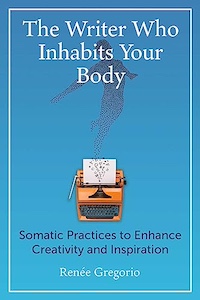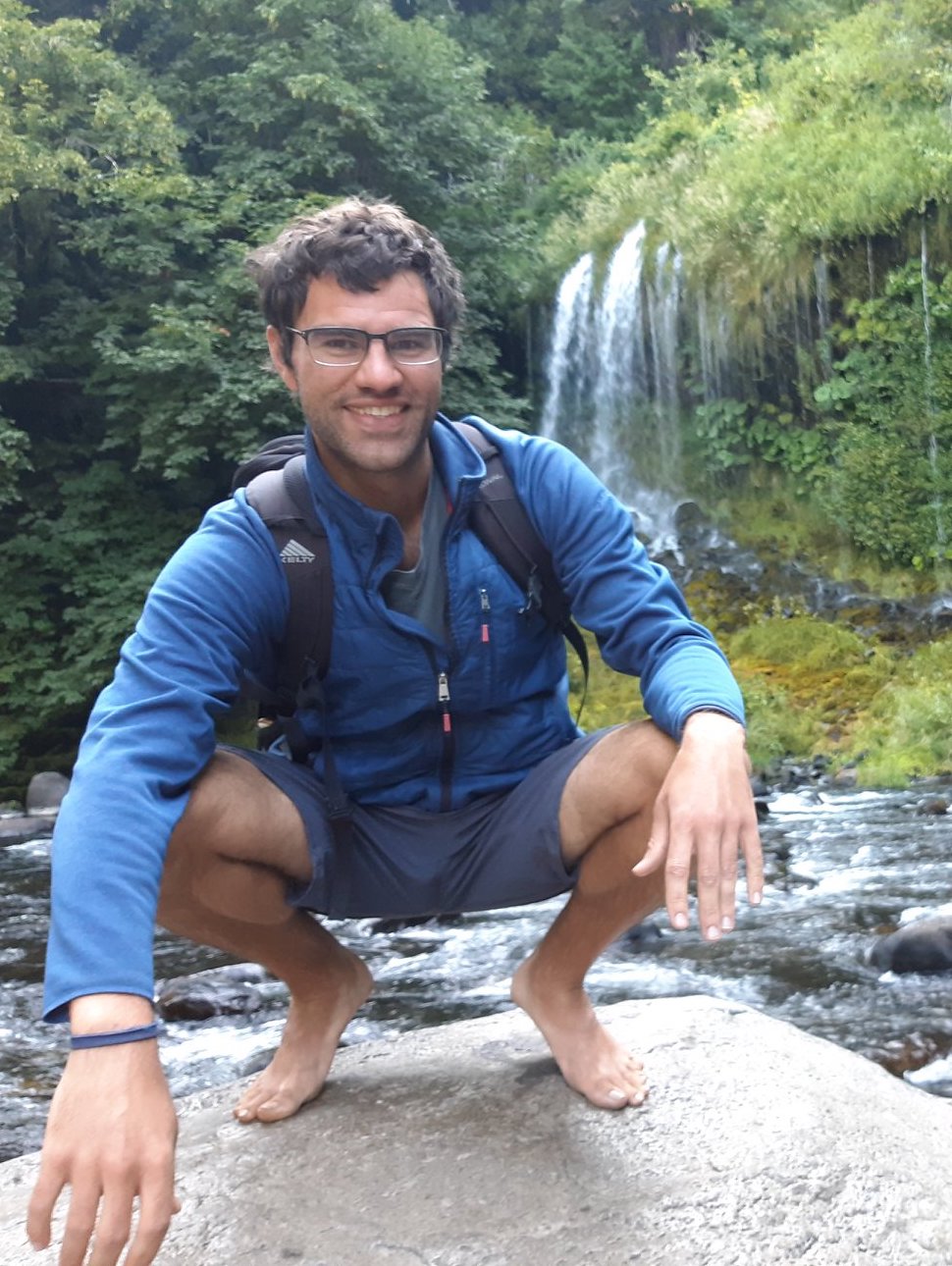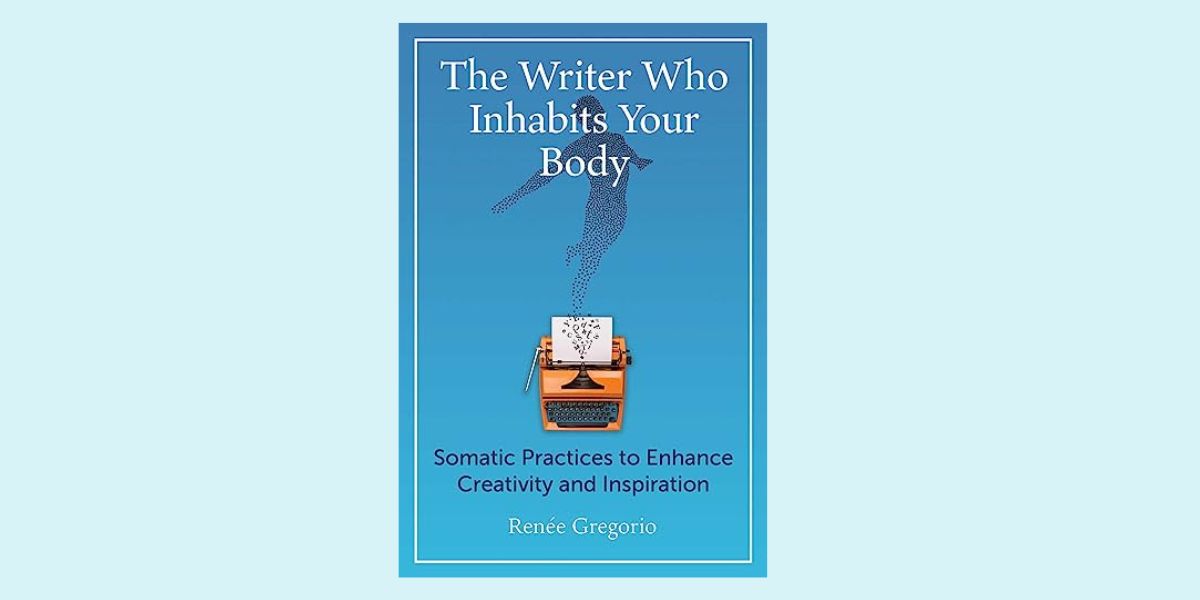
The Writer Who Inhabits Your Body: Somatic Practices to Enhance Creativity and Inspiration, by Renée Gregorio
Park Street Press, 1644119234, 192 pages, March 2024
I was unexpectedly surprised by how much I enjoyed moving through Renée Gregorio’s new book, The Writer Who Inhabits Your Body: Somatic Practices to Enhance Creativity and Inspiration. Although I can heap many praises on this book: remarking on its clean and direct writing or its superb organization and flow, what stuck out to me most was Gregorio’s stunning variety of helpful exercises. Whether you are a writer seeking to engage ever more deeply with your craft or someone simply wishing to explore your inner landscape and enrich your experience as an embodied being, you’ll find plenty of juicy content to engage with!
The text is clear and easy to digest, as one would expect from an award-winning poet. And while poetic writers can sometimes lean into style and expression a bit too heavily, potentially obscuring informative content, Gregorio demonstrates her supreme skill at communicating and evoking feelings from the reader without sacrificing the clarity of content. I believe her ability to walk this line with such grace comes from the very subject of the book–tapping into the somatic dimensions of your lived experience.
“I literally feel the words as they move through my body.It’s as if language fully occupies me, from the inside out, so that language is then born out of the body. It’s as if language and the body are really one.”1
Gregorio invites us into this exploration through her prolific use of exercises, which range from breath work and meditations to a variety of movement practices. Many of these exercises are deeply informed by Gregorio’s decades of practicing aikido, drawing upon her somatic (embodied) experience of this martial art to discover the powerful language hidden in the depths of one’s own body. Although one might think that martial arts and writing have little to do with one another, aikido has been an invaluable teacher for Gregorio because of how it relies on the interplay of energy between practitioners. By learning how to recognize, channel, and redirect the energies between herself and a partner on the sparring mat, Gregorio transmuted these insights to the dynamic between a writer and their own unique language that lies buried in their blood and bones.
At times, the amount of exercises Gregorio shares with us–usually two, if not three, per chapter!–can feel a bit overwhelming, especially if you’re the sort of person who likes to try each and every one before moving on to the next section. But not to worry, Gregorio advises the reader to pick and choose from among the exercises in each of the four main Parts of her book. As with any embodied practice, each person will have a unique experience and must experiment to discover which practices speak to them most powerfully. Thus, Gregorio’s plethora of exercises works perfectly for this method. In finding a couple exercises in each part which suit you and your writing needs, you establish a core set of practices which you can change or expand upon in the future.
As I moved further into the text, I found great appreciation for the overall organization and structure of The Writer Who Inhabits Your Body. Each of the four main Parts of the book contains seven or eight chapters which support the theme of each Part: Center is Everything, Opening the Body to Language, Turning Obstacles into Doorways, and The Roar of Your Writing. Part One begins with the most general discussion and exercises about tuning in to one’s somatic experience. Each subsequent Part then turns more directly toward the act of writing and bringing one’s embodied language out into the world.
I found this progression to be extremely helpful and well-designed to facilitate the reader’s gradual immersion into their somatic depths before trying to actively apply this to writing. As much as this book is about discovering one’s most authentic voice as a writer, it is also about unfolding one’s embodied soul through the medium of writing. Even though the practices in Part One are fairly universal–developing somatic sensitivity regardless of whether I wish to empower my writing–each contains a journal prompt that works toward integrating somatic experience and language. This led into Part Two, which focuses on creating space for your embodied writer to emerge, and deepening your relationship with that writer and the practice of your writing.
Part Three is my personal favorite, as it addresses common ways that we can get in our own way as writers. Whether fear is holding your words back, or difficult emotions and memories block you from your truest expression, Gregorio provides the means to transform each type of creative dam into a roaring river of expression. Finally, Part Four centers around harnessing the latent power of your somatic writer to bring forth the fullest and most authentic voice to your writing. This means not only discovering what you–and only you–have to write about, but also how to let your words roar off the page that can shake your audience to their core.
Sharing an insight from one of her students, Gregorio writes “at first roaring was about ‘standing up, being seen, being heard, making a difference,’ but that her definition of roaring evolved into also ‘knowing and accepting yourself so much that it is not you that roars but the words.’ Roaring is the ability to feel confident and sense your competency.”2
One of the reasons why I think this book is so effective is that many of her practices mirror those in various forms of psychological therapy. For example, exercises such as “Identifying Your Historic Patterns” and “The Mask of Self Doubt” function similarly to methods used in Internal Family Systems theory, used to help recognize and prevent one’s subpersonalities from detrimentally interfering with one another. Likewise, “Giving Shape to the Unseen” and “Accepting What’s Behind You” are reminiscent of Jungian-style shadow work. Although the practices may be similar, Gregorio’s somatic focus adds dimensions of our embodied experience that can often be overlooked in therapeutic settings.
Overall, The Writer Who Inhabits Your Body is one of the most helpful books about improving your writing that I’ve ever encountered. Even without a current writing project in my life, the range and depth of exercises are already yielding fruit. Exploring my somatic experience and journaling about my findings is certainly valuable, and has also helped in delving the depths of my soul. I definitely plan on returning to this text (over and over) to try out the different exercises, and hopefully loose my own roaring words upon the world. I don’t think it too bold to say that The Writer Who Inhabits Your Body is so approachable and applicable that it would find a home on anyone’s book shelf, regardless of their creative pursuits.

Zak has two master’s degrees in philosophy, from Brandeis University and University of California Santa Barbara. He is currently the lead editor for Dungeons in a Box, and he spends much of his time in the realm of fantasy crafting new plots and ensuring the adventure is in mechanical balance. When he’s not DMing, he also enjoys hiking, studying eastern philosophy, and playing board games.
